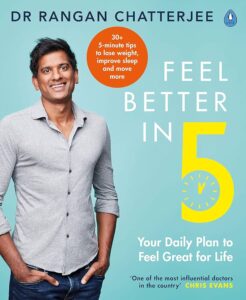
Get Moving, Not Groaning: Everyday Habits for a More Active You
Bridget Ballesteros is one of our ThriveGuides™ in The Autoimmunity Community™ specializing in habit formation and the science that goes behind creating awesome routines for our health. Her personalized program, ‘Healthy Habit Accelerator’ is a dynamic six-week program designed to supercharge your health goals, combining goal-setting strategies with sustained motivation and actionable steps towards success. Within our community, she hosts the weekly Thrive Live, “Habits that Stick with Bridget”. Get to know more about ThriveGuide™ Bridget and her personal work here.
Happy April, Thrivers! This season, brimming with the promise of renewal and reinvigoration, has blossomed around us, much like the vibrant tulips that dance joyfully under the spring sun. It’s a reminder from Mother Nature herself to awaken our spirits and breathe new life into our routines. This timely call is not just a whisper but a shout to empower our journey toward stronger autoimmune health through everyday habits for a more active you. So, in tune with this month’s theme, “Nature’s Nourishment: Reconnect to Mother Earth for Autoimmune Health,” we dive into the essence of what makes our connection with the earth so vital for our healing.
Made to Move
Have you ever watched a butterfly flit from flower to flower, or a squirrel scamper up a tree? There’s a certain magic in movement, an inherent dance that all living creatures participate in. Just like these delightful denizens of nature, our bodies are designed for motion. We’re not meant to be stagnant ponds but flowing rivers, constantly moving, evolving, and adapting. This truth is especially vital for us, autoimmune Thrivers, as activity aligns perfectly with our health and wellness goals.
Think about it: our ancestors didn’t have the luxury of sitting for hours in front of screens or steering wheels. They moved to survive, traversing vast landscapes, hunting and gathering food, and dancing to the rhythms of the earth. This constant activity kept their bodies and immune systems robust and resilient. Fast forward to today, and we find ourselves battling conditions that were uncommon in our ancestors’ time. The missing piece in this puzzle? You got that right! Movement.
“In my health journey, regular movement was difficult. I thought it had to be intensive like going to the gym or hiring a personal trainer, but I often pushed my body too much. A misconception is that we must feel sore or exhausted to get effective results.”
If we believe that we have to work out for a full hour for it to be effective, that’s incorrect. Especially for people with autoimmune conditions, overworking can strain our body or nervous system and add too much stress. It requires a measure of balance and movement that invigorates us and builds our bodies up, rather than breaking them down.
Incorporating movement into our everyday habits for a more active you is like turning the key that unlocks the door to improved autoimmune health. It’s not about running marathons or lifting heavy weights (unless that’s your jam!), but finding joy in the simple acts of walking, stretching, and breathing deeply. These activities reduce inflammation, boost mood, and enhance our connection to our bodies and the natural world around us.
In fact, recent research found that regular exercise, even low-impact activities like walking, can significantly reduce inflammatory markers in people with autoimmune diseases. And the benefits go beyond the physical, too!
Regular aerobic exercise has significant benefits for mental health, with the Anxiety and Depression Association of America (ADAA) reporting that it can be as effective as medication for improving symptoms of depression and anxiety.
Engaging in regular physical activity reduces tension, improves mood stability, betters sleep patterns, and can increase self-esteem. Notably, these positive effects on anxiety can start to take hold with just five minutes of aerobic exercise, offering a quick and effective strategy for those seeking mental health support.
 Imagine the gentle stretch of your muscles as you reach for the sky (kind of like a tree), the deep breath of fresh air that fills your lungs in a peaceful meadow, or the soothing rhythm of a walk in the woods. These moments are not just physical activities; they’re rituals that honor our humanity as beings made to move.
Imagine the gentle stretch of your muscles as you reach for the sky (kind of like a tree), the deep breath of fresh air that fills your lungs in a peaceful meadow, or the soothing rhythm of a walk in the woods. These moments are not just physical activities; they’re rituals that honor our humanity as beings made to move.
Benefits of Movement for Autoimmune Well-being
Living with an autoimmune condition can be challenging, but lifestyle changes can significantly impact your overall health and well-being. Here are some compelling reasons why incorporating movement into your everyday habits for a more active you:
1. Holistic Approach
Lifestyle changes, including regular physical activity, offer a holistic and empowering approach to managing autoimmune symptoms. Rather than relying solely on medications, movement becomes an essential part of your self-care toolkit.
Embracing a holistic approach means recognizing that managing autoimmune symptoms extends beyond traditional medication. It’s about integrating lifestyle changes—like regular physical activity—into a comprehensive plan for well-being. This philosophy empowers us to see movement not just as exercise, but as a vital element of our self-care toolkit that supports the body’s natural balance and healing capabilities. By taking this broader view, we acknowledge that every aspect of our lives plays a role in our health, and we become active participants in our journey toward wellness.
2. Reduced Inflammation
Exercise has been linked to reduced inflammation in the body. Chronic inflammation is often associated with autoimmune conditions, so engaging in regular physical activity can help mitigate this underlying issue.
3. Enhanced Immune Function
Movement supports immune system function. It enhances vagal tone, which suppresses pro-inflammatory cytokines through the cholinergic anti-inflammatory pathway.
Additionally, exercise reduces the activity of the hypothalamic-pituitary-adrenal (HPA) axis, leading to lower cortisol levels and improved immune responses. You can read more about this research HERE.
4. Stress Reduction
Changing your posture, breathing, and rhythm through movement can alter brain activity. This reduction in stress, depression, and anxiety contributes to an overall sense of well-being. By synchronizing your movements, you protect yourself from the damaging effects of chronic inflammation.
 5. Sunlight Exposure
5. Sunlight Exposure
Regular outdoor movement exposes you to sunlight, fresh air, and nature – all the best things in life without spending a dime! Also, did you know that sunlight helps regulate immune function and manage stress, both of which are crucial for autoimmune health? Fascinating, isn’t it?
Remember, movement doesn’t have to be intense or extreme. Even gentle activities like walking, running, or swimming can make a significant difference. Consult with your healthcare provider to find the right movement routine that suits your individual needs and limitations.
Unlocking Everyday Movement: Simple Strategies for Active Living by ThriveGuide™ Bridget
1. Identify “movement moments”
Bridget reminds us that life is full of hidden opportunities for motion. It’s like finding secret treasure in our day-to-day activities. Let’s think about where we can sprinkle little bursts of movement. Maybe it’s taking the stairs instead of the elevator, parking a little further from the store entrance, or doing a little dance while making our morning coffee. These moments are golden chances to get our bodies in harmony with our health goals.
2. Try “habit stacking”
Imagine building a tower of wellness, one block at a time. That’s habit stacking! It’s about linking a new, small movement habit to an existing one. So, while you’re brushing your teeth, why not do a few calf raises? Or every time you send an email, take a stretch break. It’s the little things that add up to a big difference.

Credits: drchatterjee.com
Dr. Rangan Chatterjee, a UK-based doctor and author of the book Feel Better in Five, emphasizes this approach. His work presents five-minute routines, including workouts and mindfulness exercises. According to his research and patient interactions, these short routines can considerably impact by fostering long-term lifestyle changes.
Therefore, consider incorporating such routines with your morning coffee or perhaps with a mindfulness or meditation activity.
3. Leverage visual cues
Our environments are like our assistants, ready to nudge us towards healthier habits. Adding visual reminders in your everyday environment increases the likelihood of undertaking a specific habit.
Place those walking shoes by the door to invite you for a stroll. Hang that resistance band on the fridge door handle, so you think of strength training as you reach for a snack. These visual nudges encourage everyday habits to a more active you by making movement a natural part of our routine.
4. Be proactive with scheduling
Bridget’s advice here is like setting an appointment with health. Carve out time in your calendar for movement as if it’s the most important meeting of your day—because it is! Whether it’s a five-minute stretch break penciled in between meetings or an after-dinner walk, making it a non-negotiable part of your schedule reinforces its importance. The goal, after all, is to establish everyday habits for a more active you.
5. Lean on support
Walking this path alone can be tough. So why not make it a group adventure? Team up with friends for a walking club or find a buddy to try out that new dance class. Leaning on each other for motivation and accountability makes the journey more fun and the habits stickier.
And that’s what our BrightlyThrive™ Community is all about. Whether you’re looking for a workout partner, advice on the best trails for a nature hike, or just some encouragement after a long day, our community is here to lift you up.
For me, it was a game-changer to combine my social connection goals with others like eating healthier and moving more. This alignment was crucial because my social activities weren’t quite aligned with my newfound changes in health. Yet, I’ve managed to nurture friendships that are supportive of our mutual health or found new ones entirely.
Engage with your fellow Thrivers in the Autoimmunity Community space, join our monthly challenge event, or DM a fellow Thriver in your area or ThriveGuide™ for encouragement or tips on new and safe workout ideas you can try. Remember, every step you take is more powerful with friends cheering you on. So, let’s connect, support, and thrive together. After all, wellness is a journey best shared!
Step Into Action: Embracing Movement for Autoimmune Strength
In the dance of life, every step counts—especially when it comes to our autoimmune health. As we wrap up this exploration of movement with ThriveGuide™ Bridget Ballesteros, we’re reminded that our bodies are our allies, designed for movement and rhythmic harmony with the world around us.
Ready to learn more from Bridget and the other ThriveGuides™ within The Autoimmunity Community™ on how to build everyday habits for a more active you? Grab the opportunity to become one of our members by visiting our homepage to apply today.
As we step into action, let’s carry with us the wisdom of identifying ‘movement moments,’ the creativity of ‘habit stacking,’ the clever use of visual cues, the proactive power of scheduling, and the irreplaceable value of community support. Each of these strategies is a thread in the tapestry of our journey to autoimmune strength.

Let’s not just dream of better health; let’s walk toward it, one joyful step at a time, with the BrightlyThrive™ Community by our side. Together, we’ll turn movement into a celebration of life, discovering not just the strength of our bodies, but the resilience of our spirits. So here’s to moving, thriving, and stepping into a future where our autoimmune strength is our superpower.
Resources
G., & G. (2024, February 6). Research shows working out gets inflammation-fighting T cells moving. Harvard Gazette.
Exercise for Stress and Anxiety | Anxiety and Depression Association of America, ADAA. (n.d.).
Duclos, M., & Tabarin, A. (2010, September 24). Exercise, Training, and the Hypothalamo–Pituitary–Adrenal Axis. Hormone Use and Abuse by Athletes, 9–15.
The Ultimate Guide to Lifestyle Changes for Autoimmune Health. (n.d.). WellTheory.
- (n.d.). Why Mindfulness can help the Immune System – CNMB Lab.
How simply moving benefits your mental health. (2016, March 28). Harvard Health.
Wellness, A., & Trescott, M. (2023, March 28). The Benefits of A Regular Walking Routine – Autoimmune Wellness. Autoimmune Wellness.
The Secret of Sunlight: How it Naturally Affects the Immune System. (2023, June 14). Maggie Roney, Counselor, MS, NCC, LPC, ICP, AFMC.
TAGS:
CATEGORIES:








